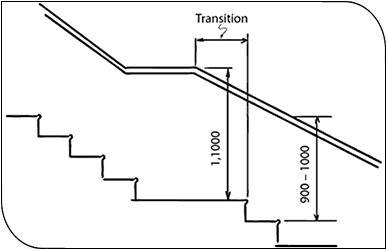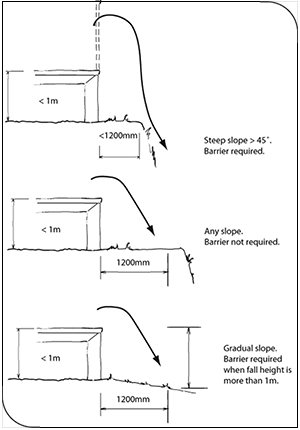Barriers and handrails
The need for a barrier when someone could fall vertically one metre or more is made clear in Building Code clause F4.
Measuring the height of fall from a deck
Clause F4 (Safety from Falling), in F4.3.1, states:
Where people could fall one metre or more from an opening in the external envelope or floor of a building, or from a sudden change of level within or associated with a building, a barrier shall be provided.
If a deck or patio is 1.5 metres above a flat lawn, then the height someone could fall is obviously 1.5 metres. A ‘fall’ need not be vertical, though. One dictionary definition of ‘to fall’ is ‘to descend rapidly from a higher to a lower level’.
Unfortunately fatal mountain climbing falls occur from time to time, but many of them are not vertical falls. A slope of 45° is steep enough for someone to tumble down and injure themselves (stairs in a house typically have a slope of about 40°).
A court decision some time ago (Judge MA Frater, District Court Gisborne, 29 May 1998) dealt with a situation where there was a cliff with a platform at the top, 800mm above a small retaining wall and set back about one metre from it.
The judge said “it seems to me that the slope of the cliff face is such that if anyone fell from the platform or from the handrail level, they would be unlikely to fall neatly and directly into the small space of less than one metre between the edge of the platform and the outer retaining wall. The more likely scenario is that they would fall down the hillside onto the rocks below.”
Recent determination decision on ‘safety from falling’
Determination 2008/81 considered the situation where a proposed low deck, 500mm high, would be close to a steep rock retaining wall. If there was no barrier on the deck, the determination concluded the deck needed to be 1200mm from the face of the wall to protect people from falling off the deck and tumbling down the wall.
The need for a barrier on a low deck
Determination 2008/81 has made clear that the horizontal distance to a steep slope must be considered when deciding the need for a barrier on a deck. In light of this determination, where the ground slopes gradually away from a deck a reasonable approach is to measure the height of fall at a distance of 1200mm out from the deck.
Determination 2008/081 Safety barrier to a deck located adjacent to a retaining wall.
Building consents for low decks
A low deck may not need a building consent. The Building Act's Schedule 1 lists the building work not needing a consent. Included is ‘the construction or alteration of any platform, bridge, or the like from which it is not possible for a person to fall more than one metre even if it collapses’. In most cases, therefore, if a deck does not need a barrier, it will not need a consent. However it is still a ‘building’ and its construction must comply with the Building Code.
Handrail heights on stairs and landings
The Acceptable Solution D1/AS1 says Clause D1 requires handrails on all stairs. Handrails must be ‘positioned between 900 and 1000mm above the pitchline’. The pitchline is defined as ‘the line joining the leading edge or nosings of successive stair treads’.
The Acceptable Solution F4/AS1 (Table 1) requires barrier heights in buildings other than housing to be 900mm on stairs and ramps, and 1100mm elsewhere. Thus the barrier height on a landing, other than in housing, must be 1100mm. If the stair handrail is fixed on the top of the stair barrier and carried onto the landing barrier, it will be 1100mm high on the landing. This height is acceptable because the function of a handrail is to provide safety on a stair flight and its height on a landing is not critical. The handrail (and barrier) can rise to the 1100mm height over a transition zone about 300mm long, depending on the stair slope.
Barriers and Clause B2 ‘durability’
Acceptable Solution B2/AS1 Table 1 specifies the durability requirements of nominated building elements. Table 1 states that safety barrier support posts and handrails must have a durability requirement of not less than 50 years. A ‘handrail’ is a defined word in the Building Code, but in the context of a barrier means the top rail of the barrier.
Table 1 states a durability requirement of not less than 15 years for balusters. The words ‘baluster’ and ‘balustrade’ are both defined in the B2 Compliance Document. A ‘baluster’ is defined as ‘a post providing support for the top and bottom rails of a barrier’ and ‘balustrade’ as the ‘infill parts of a barrier’. In this context, therefore, the balusters are part of the balustrade or infill, and not the main support posts for the barrier.

